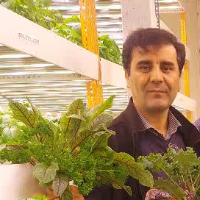Design and Development of a Solar Hydroponic Rotary Cropping Apparatus with an Intelligent Irrigation System
Author(s):
Article Type:
Research/Original Article (دارای رتبه معتبر)
Abstract:
Introduction
Global increase in the food demand and challenges regarding the water, energy and fertile soil has made it clear that current strategies are no longer efficient for maintaining food safety. Therefore, attention to novel, science-based, seasonal and climate-independent farming methods which could result in the higher crop quality and quantity is an inescapable decision. Among all agricultural practices and technologies, intensive culture and hydroponic methods in controlled environments play an important role.Materials And Methods
To address these challenges, an indoor solar-powered auto-irrigate rotary cropping system (SARCS) was designed and implemented. Arrangement of plants in the surface area of an open-ended drum makes it possible to use space rather than area to maximize the acreage. An embedded fuzzy control system managed the irrigation process based on the plant water requirement predictions, and photovoltaic panels (PVs) was responsible for system electrical energy provision. The drum rotates around its horizontal axis where LED lamps are positioned to provide light to plants. This structure causes the plants gain the light illumination efficiently while getting access to water accumulated in the secondary tank positioned beneath the drum. Fertigation fuzzy control was based on plant evapotranspiration (ET) estimations with temperature, humidity, and light as its inputs. The instantaneous estimated ETs which were measures for root substrate moisture were summed until reaching its critical value which is equivalent to plant readily available water (RAW). This tends to trigger a pump submerged in a primary tank to fill the secondary one up to a predefined height ruled by a level sensor. The solar energy system consisted of PVs, MPPT, inverter, and battery bank. The SARCS evaluation procedure included two valid lettuce cultivation in grow bags filled with the same proportions of perlite and coco peat as a root substrate. The first cultivation used water level sensors to rule the irrigation process (non-fuzzy) while the second one (fuzzy) were governed by fertigation cycle fuzzy control.Results And Discussion
The results showed that employing these two modes increased lettuce planting density to about 12 times in the field culture and 4 times in the greenhouse. The energy consumption evaluation revealed that in fuzzy and non-fuzzy approaches the same amounts of energy were needed. But in fuzzy mode the amount of energy consumed per kilogram of marketable lettuce was 74.33% less than in non-fuzzy mode. Fuzzy and non-fuzzy modes utilized 58.81% and 48.41% of the total energy requirements from PVs, respectively. It was calculated that the solar system is able to supply 51.16 % of SARCS total annual energy requirements in Karaj Province. The results of water consumption evaluations revealed that the fuzzy approach could cut the needed water to 24%, and improved the marketable product to 74.47%. For producing one kilogram dry and fresh biomass, fuzzy mode used 50.41% and 55.53% less water than non-fuzzy, respectively. Furthermore, one kilogram marketable product in fuzzy approach needed 56.46% less water than in non-fuzzy. The averaged water needed for growing one lettuce plant in non-fuzzy and fuzzy modes were 15 times less than in field lettuce. The comparison of growth parameters of harvested lettuce in the two studied approaches revealed that fuzzy mode would have significantly higher results in all parameters.Conclusions
The results suggested that the development of intensive culture strategies would play an important role in the sustainable agricultural production and food safety. Also, the solar energy utilization in farming practices could save fossil resources and decrease air pollutions. Finally, purposeful irrigation approaches which are based on plant water requirement predictions can significantly reduce the total water consumption and improve products quality. This strategy, therefore can be introduced to other farming practices such as field and greenhouse methods.Keywords:
Language:
Persian
Published:
Journal of Agricultural Machinery, Volume:8 Issue: 2, 2018
Pages:
279 to 294
magiran.com/p1862428
دانلود و مطالعه متن این مقاله با یکی از روشهای زیر امکان پذیر است:
اشتراک شخصی
با عضویت و پرداخت آنلاین حق اشتراک یکساله به مبلغ 1,390,000ريال میتوانید 70 عنوان مطلب دانلود کنید!
اشتراک سازمانی
به کتابخانه دانشگاه یا محل کار خود پیشنهاد کنید تا اشتراک سازمانی این پایگاه را برای دسترسی نامحدود همه کاربران به متن مطالب تهیه نمایند!
توجه!
- حق عضویت دریافتی صرف حمایت از نشریات عضو و نگهداری، تکمیل و توسعه مگیران میشود.
- پرداخت حق اشتراک و دانلود مقالات اجازه بازنشر آن در سایر رسانههای چاپی و دیجیتال را به کاربر نمیدهد.
دسترسی سراسری کاربران دانشگاه پیام نور!
اعضای هیئت علمی و دانشجویان دانشگاه پیام نور در سراسر کشور، در صورت ثبت نام با ایمیل دانشگاهی، تا پایان فروردین ماه 1403 به مقالات سایت دسترسی خواهند داشت!
In order to view content subscription is required
Personal subscription
Subscribe magiran.com for 70 € euros via PayPal and download 70 articles during a year.
Organization subscription
Please contact us to subscribe your university or library for unlimited access!



